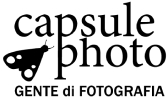Capsule Photo

Capsule Photo by Gente di Fotografia is the new editorial series from Gente di Fotografia Edizioni.
Books that tell stories, the visions of authors who capture fragments of existence and transform them into something universal.
Author's publications where each volume is unique, the result of a creative process that combines artistic vision and typographic excellence: from the careful choice of paper to the color rendering, from the refined binding to the innovative and coherent design.
Thanks to Gente di Fotografia Edizioni's distribution channels, Capsule Photo by Gente di Fotografia reach specialised libraries and photography lovers.
Capsule Photo by Gente di Fotografia: small print runs, new formats, great feelings.
Massimo Magistrini: IN - Collana CAPSULE PHOTO di Gente di Fotografia

Author: Massimo Magistrini
Texts: Laura Manione, Massimo Magistrini
Pages: 84 + endpapers
Languages: Italian/English
Month/Year: July 2025
Formato: 175x260 mm
Binding: Swiss paperback hardback spine, book block glued to back cover
Printing run: 100 copies
ISBN 978-88-88290-12-6
€ 65,00
It is
around grammar that Massimo Magistrini's work revolves, like the needle of a
compass.
The very title of the book is entrusted to a preposition, In,
which later becomes a prefix to introduce the internal sections. With a daring
move, a simple particle takes on the task of deciphering a complex work,
articulated in several series that, when considered as a whole, provide a
precise vision of photography and the natural world.
Behind the camera, the author adopts the attentive gaze of the hiker who moves
through minimal environments but knows how to imagine boundless realities,
scrutinizing and consulting woods, herbs, wildflowers, moss, and ancient
nautical maps. [...]
In-canto
(TN: en-chantment) is the chapter that opens the book and transports us
into the woodland dimension, into an archetypal place where exuberance and
mystery dwell. It is the double exposure in-camera - not in post-production -
that gathers them both, giving life to a process of sedimentation and
transformation that alludes to the physiological and symbolic implications of
forest regeneration.
In-colto
(TN: un-tended),
which follows, instead interprets the idea of a garden, a well-protected hortus
conclusus, well guarded by the edges of the image and populated by
common yet extraordinary specimens. Here, in addition to the double exposure
that emphasizes various combinations of elementary botanical forms, it is the
black and white that synthesizes the entire sequence, converting it into a
gallery of sophisticated tapestries.
In-esplorato
(TN: un-explored),
lastly, contains two fantastic maps created with images of mosses and conifer
leaves, to which a third map is added, built with details extrapolated from an
ancient portolan chart. [...]
(Laura Manione)
iara di stefano: di Miele e di Fiele - Collana CAPSULE PHOTO di Gente di Fotografia

Author: iara di stefano
Texts: iara di stefano, Laura Manione
Pages: 84 + endpapers
Languages: Italian/English
Month/Year: June 2025
Format: 145x195 mm
Binding: Hardcover, sewn, square spine + ochre headbands, cover on Assuan fabric with powder pink screen printing
Printing run: 120 copies
ISBN 978-88-88290-11-9
€ 30,00
Honey and Gall—two substances with opposing sensory profiles, often entwined in symbolic contrast. “Mel in ore [...] fel in corde” (honey in the mouth, gall in the heart), reads a medieval Latin proverb; “in corpo fiele, in bocca miele” (gall in the body, honey on the lips), wrote Pirandello in The Man, the Beast and the Virtue.
With this title, Iara Di Stefano invokes an ancient dualism to frame the narrative of a pivotal year - a turning point in her own life. The book unfolds through contrasting materials and shifting registers, creating a rhythm of fracture and recomposition. Yet from these apparent disruptions, a kind of organic unity emerges - almost biological in nature. The photographs act as surfaces upon which both sweetness and bitterness accumulate, like traces left behind by experience.
(from the presentation text by Laura Manione)
Silvio Canini: UMBRATILE - Collana CAPSULE PHOTO di Gente di Fotografia

Author: Silvio Canini
Texts: Sabrina Foschini, Loredana Cavalieri, Silvio Canini
Pages: 60
Languages: Italian/English
Month/Year: March 2025
Format: 182x210 mm
Binding: 3-panel cover on Fedrigoni Materia Terra Gialla 250 g - Packed bare spine, visible thread gray
ISBN 978-88-88290-10-2
€ 25,00
It was common in the 1960s, and perhaps even earlier, to rent out one’s home to vacationers who came to spend their holidays by the sea, in order to earn some extra money. Meanwhile, we would sleep in the garage, where we had managed to set up a bathroom.
The less fortunate made do in the shed.
Tourists would stay for the entire season, bringing the whole family along, including grandparents. Only the father sometimes had to return home to work — unlike today, when even managing a weekend away feels difficult.
My parents owned a haberdashery on the main avenue and didn’t have much time to look after me, so during the summer, I became the child of the tourists and a sibling to their children. I often ate with them and spent the whole day at the beach, making the most of the sun until it disappeared.
I remember that towards the end of the day, we would search for the last rays of sunlight to finish our sandcastles, as those giant concrete buildings cast long shadows.
(Silvio Canini)
